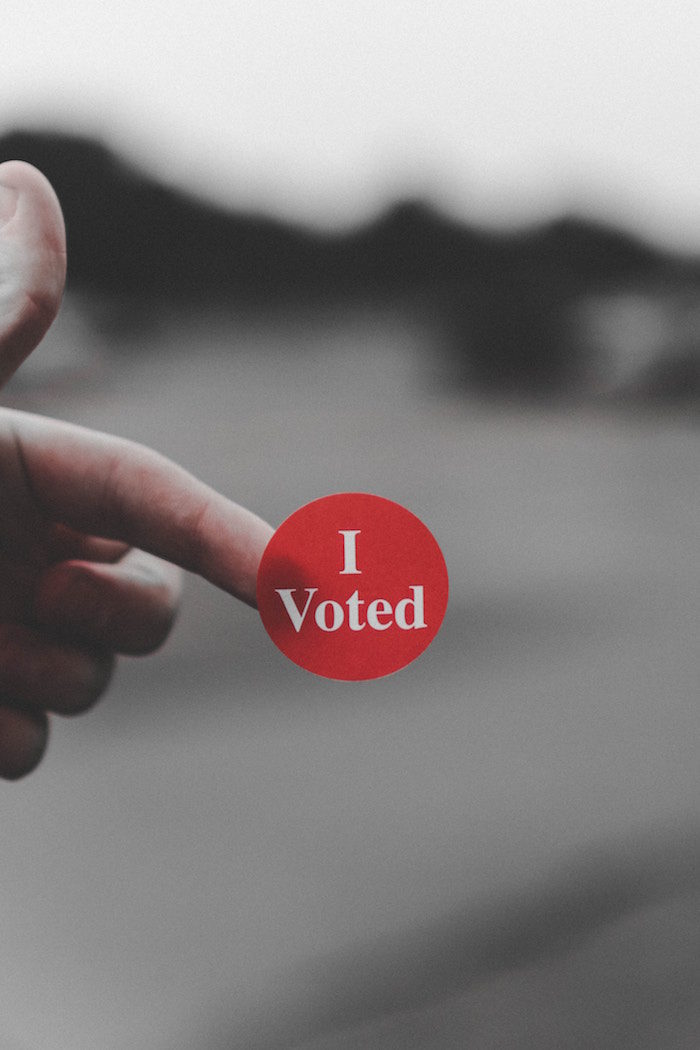- A version of this article was originally published on Ecocult, a leading blog about sustainable fashion and travel.
 I have something shameful to admit to you, readers.
I have something shameful to admit to you, readers.
I’m really sorry, but I’m not voting in the midterms in November.
I wish I had a better excuse. It’s simply because my husband and I are traveling this year, and in order for us to request, receive, and send back absentee ballots, we would have to settle at one address where we can reliably receive mail for at least two months. Since we will be moving all over India from week to week so I can visit ethical fashion workshops, an absentee ballot is not in the cards.
I don’t feel great about this. When I first started blogging, I had a real distaste for politics. But three things have changed my mined. First, I haven’t seen any evidence that taking an individual approach to improving the world and trying to convince people to be better consumer has yielded results. Second, I’ve seen the lasting damage that our current administration is doing to the environment. Finally, I’ve traveled through a dozen countries in the past ten months that are corrupt, autocratic, or otherwise broken, and I’ve come to appreciate the role of our well-functioning democratic government in protecting the environment. Funding for research, endangered species protection, and national parks are all determined by the government. Whether polluters and unscrupulous developers who build on fragile ecosystems are punished is a function of the government. Whether recycling is available and tap water is drinkable is a function of the government. I could go on and on, but the biggest crisis of our time, climate change, is all dependent on whether the U.S. government gets back on board with the Paris Climate Agreement.
And these midterms are outrageously important. With double the number of total people up for election across the country (80,000 now versus 40,000 in 2016), some say the midterms are twice as important as the presidential election. They’ll determine redistricting after the census, which helps locks in power for the incumbent political party for the next decade. In fact, if Democrats don’t win back power, the environment will suffer for a whole generation as Republicans continue to attack environmental protections, defund the EPA and other agencies, and giveaway concessions to polluters. Plus, many of the battles being waged over environmental policy changes by Trump will be determined in the courts, and it’s the Senate that will choose to confirm or reject his court appointments.
The crazy part is that many environmentalists don’t bother voting! Whether out of apathy, cynicism, or a misguided belief that individual actions are more important than getting involved in politics, in the 2016 election, “only 50 percent of environmentalists voted in the 2016 presidential election, compared to 69 percent among all registered voters,” according to the Environmental Voter Project.
In the 2014 midterm elections, only 21 percent of environmentalists voted, compared to 44 percent among all registered voters. Low turnout poses an obvious problem in that it affects the outcome of close elections, but its true impact is far greater and longer lasting due to an often overlooked mainstay of modern politics: polls of “likely voters.” When environmentalists don’t vote, they aren’t considered “likely voters,” which means they won’t get called by pollsters. Consequently, environmental concerns have become under-represented in the electorate, leaving candidates, policymakers, and the media to focus on other issues.
Here’s how to make your vote count, then multiply it.
1. Register to vote NOW.
The deadline to register to vote in the 2018 midterms varies from state to state, but if you’re in Alaska, you need to register by October 7th. There are other deadlines this week. Some states let you register online, but others require you to do so in person or by mail. Here is the entire list of voter registration deadlines by state. And here’s how to check to see if you’re registered, if you’re don’t remember.
2. Make a plan for voting.
Find out the location of your local polling station. Pull out your calendar and note down the open and closing times for your local polling station.
Then, block out some time to go vote, with multiple alerts on your phone and computer. Voting before work is way better than after work, by the way, because you’re tired after work (decision fatigue might lead to poor choices at the polls) and also it’s possible something will come up to keep you at the office until it’s too late.
Clear your calendar of any morning meetings. Also double check to make ensure you have everything you need to vote in your state, such as a photo ID, utility bill, etc. If you can’t go in person, check out Rock the Vote for instructions on how to cast an absentee ballot. Often absentee ballots are due before election day, so don’t procrastinate on this! (If you’re mailing in your ballot, put two stamps on there, just in case. )
Are you planning on getting out the vote this midterm elections?
Related: This Janet Yellen-Endorsed Carbon Tax Might Be The Best Chance We Have At A Climate Solution
Angry About Politics? 40 Ways To #Resist For The Earth, Right Now
__
Photo: Parker Johnson on Unsplash




